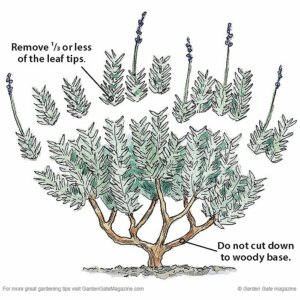Planting and Caring for Lavender

Lavender plants are offered in the spring and fall. You may preorder plants and sign up to participate in Lavender Planting Clinics. Sign up for the Lavender Letters for plant availability ahead of the clinics. If you’re local, enjoy the ease of farm pick up or shop the farm’s Lavender Love Shop & Farm Market when it is open during events. US shipping is available.
For the love of lavender! Every home deserves at least one lavender plant. By the mailbox, at the front steps, along a sidewalk or as a foundation plant or in your garden, with proper site location, bedding preparation and annual pruning, lavender can be grown and enjoyed in our compact clay soil, hot, humid summers and wet winters.
FAQs about Growing Lavender
The Mediterranean is home to the sweetly scented perennial herb, lavender. Think the south of France!
A perennial herb, lavender matures to a shrub in its third year.
Due to the high oil content of the foliage and flowers, the deer and bunnies tend to avoid eating lavender.
 In our USDA Planting Zone of 7b in central North Carolina, pruning begins in mid-February (think Valentine’s Day as a reminder). For those gardening in other zones, wait to prune the lavender until after the coldest part of winter.
In our USDA Planting Zone of 7b in central North Carolina, pruning begins in mid-February (think Valentine’s Day as a reminder). For those gardening in other zones, wait to prune the lavender until after the coldest part of winter.
If lavender plants have received an annual trim, snip away about 1/3 of the soft green foliage, leaving at least 2-3 inches of green leaves, guarding against trimming into the woody parts of the plant. You want to trim the plant neatly to resemble a rounded boxwood.
If the lavender has gone several years without pruning and looking overgrown, spend the time to check for decaying woody stems, remove them and carefully shape the plant. Again, the rule of thumb is to leave at least 2-3 inches of soft green foliage on the plant. It may take several attempts to rejuvenate your lavender plant, or it just might be time to install a new one. Pruning is essential to gorgeous and productive lavender.
Use any kind of shearing tool that you’re comfortable with. Weed eaters, hedge trimmers, hand tools and even kitchen scissors work just fine.
Don’t discard the trimmings! Use them around “deer candy” flowers, shrubs and trees in your yard, tie them up, open a window and place the trimmings on the windowsill or toss them on the grill as a layer between the grill surface and the produce or protein you’re preparing to eat. The taste is subtle and oh so delicious!
Likely, the plant is stressed due to root rot. There’s too much moisture in the soil.
Potential solutions:
- Cut away dead material in April or May in southern gardens once new green foliage has started to emerge to clean up the lavender plants.
- Scatter stone or pebbles around the base of the plant.
- Push the stone into the soil and aerate the soil at the same time by pushing the prongs of a garden fork around the drip line of the plant.
- Yes. Follow the same instructions for planting lavender in containers. Be sure to know the mature diameter of the lavender and choose an appropriate container. Remember that lavender is shallow rooted, so the pot does not need to be a tall one. Average depth and spread of the root system is 8-10 inches.
- Excellent drainage is key to success with lavender be it in the ground or in a pot. The pot will need to be watered more frequently in the heat of the summer as they dry out quickly. This could mean nearly every day in July.
- Keep in mind that lavender prefers to live in the garden or in a pot outdoors. Requiring significant sunlight, it is nearly impossible for them to thrive as a houseplant. So, it is best to find a sunny, well-draining location in the garden, or a pot, for your lavender.
- Temperatures are 15 degrees colder above the ground than in the ground. With this in mind, protect the pots by wrapping them or covering the plants when the temperatures are below freezing.
No. 6 hours of bright sunlight is required for lavender to thrive.
Growing plants is best. Seed is about 15% viable. With weeks and weeks of patience (like up to 6 months), a packet of seeds may result in a few plants.
Please don’t! The lavender plant will die. Lavender does not spread like some perennials do.
Remember – Hot, Dry and High! Lavender appreciates reflective light.
- Southwestern exposure
- Slopes, banks or raised beds
- Pool side
- Along a roadway or sidewalk
- Foundation of brick or stone wall
Your plant may look like it’s dead. What time of year is it? Here’s what you can expect your lavender to look like throughout the seasons:
Winter: Lavender may or may not still have its foliage from the previous year. Lavender is dormant once freezing temperatures begin in the fall (October / November) until they end in spring (April) Lavender foliage can turn gray / green and even bronze colored. Depending on the amount of cold and moisture, your lavender plants may lose some foliage. Some leaf loss is expected in southern gardens due to the humidity.
Spring: New green emerges in April, once the garden is experiencing consistent temperatures in the 80’s. Patience please. Wait until Memorial Day to pull out your lavender plant!. Not native.
Summer: Lavender varieties that grow in southern gardens bloom from the end of May, throughout June and some into early July, predominantly. You may get sporadic blooms until freezing temperatures in the fall.
Fall: Lavender foliage remains green and lush.
Planted properly, lavender can last up to 10+ years in the garden.
Despite our best efforts, we will lose lavender plants when growing lavender in the humid south.
Lavender plants offered from the farm are hardy in USDA Plant Hardiness Zones 5 – 9.
Soil for Lavender

- Use well-drained soils or raised beds and containers (outdoors only).
- Soil should be well draining. There is no need for a special soil, just one that is not compact. If gardening in clay soil, the soil must be amended. Use 50/50 stone or pebbles to native soil.
- Soil should have low fertility.
- Lavender prefers alkaline soil. pH should be 6.5 or higher and is easily measured with a simple soil test (a soil test is not absolutely necessary since typical southern clay benefits from the addition of lime – and a lot of it – to boost and retain an increase in the pH level.)
- Lavender is a perennial herb. If you are concerned about winter survival, protect the plants by covering with a straw mulch until the danger of extremely cold temperatures has passed. Be mindful that lavender does not like moist conditions, so planting with sharp drainage is especially crucial if planting lavender in areas that are not appropriate for the growing zone.
- Water your lavender well in its nursery pot every day. Soak it deeply in the evenings, daily until planted, then water again for about an hour before planting, and of course, after as well.
- Prune the top of the plant to ensure a productive plant.
- Loosen the roots from the potting soil by working the trowel teeth into the soil block.
- Place plant just above the blend of stone/ lime / bonemeal / compost, not allowing the roots to touch the blend and gather soil around base of plant. Water deeply.
- Space largest plants 5 – 6 feet from one another for good air circulation.
- Lavender blooms at its peak in its third year producing about 1000 stems
Pruning Lavender

The goal is to prune the lavender once a year. With trial and error, you will discover what works best for your garden. Given the garden location, imagine what would happen if you trimmed your lavender and there was a deep freezing cold snap. Remember, lavender likes southwestern exposure and protection from winter wind. Given the ideal site for lavender, should you trim around Valentine’s Day, then the region dips into frigid temps, chances are that your lavender will be just fine and bounce right back.
Why Prune? Pruning will help the plant grow full and rounded and deter sprawling, which can cause the main stems to split and break.
- Trim off 1/3 of lavender foliage, leaving at least 2–3″ of green, soft foliage, taking care not to cut into the woody part of the plant.
- In late winter while dormant, by the end of February (in Zone 7b). Toss a handful of bone meal/lime/compost blend around the base of the plant (or it can be done with fall garden chores) and just before rain or water afterwards.

Tips
- Prune after the coldest part of winter in your area, which is around Valentine’s Day, on the farm.
- Yes, the winter weather has been a roller coaster here of warmth, then cold, then snow, then warmth, then … you get it!
- When considering the best time to prune your lavender, it is important to ask the gardener’s questions.
- In looking at the weather predictions through February, is your garden beyond the coldest part of the winter season? Should the task wait? Can it wait?
Harvesting Lavender

- The lavender varieties that grow well in our area will bloom from about Memorial Day to July 4th.
- When the bottom flowers are just opening, the lavender is at its peak for color and fragrance, cut the stems down to the foliage.
- Gather about 100 stems and tie them together. You may turn them up-side-down, suspended from a nail, string or wire in a hot, dark, dry location for drying, like an attic, storage area or closet.
- Allow the lavender to dry for about 10-14 days, depending on the conditions. Dried lavender will retain color and fragrance.
Keeping Fresh Lavender

- If you enjoy fresh lavender in the house, cut it when it blooms and do not place it in water. The water just accelerates the florets falling off of the stems and the stems get very mushy, messy and yes, smelly.
- So, just cut them, place them in a vase, bottle, basket — whatever! — and enjoy. They will dry on their own. Grosso and Hidcote dry very nicely this way and the florets stay on the stem quite well.
Best Tips for Growing Lavender
- Full Sun At least 6 hours. Full throttle!
- Excellent Drainage Like rock gardens & raised beds – lots of stone.
- Air Circulation 4 inch pots grow into 3 foot diameter shrubs. Keep clear of any creeping ground cover, or weeds, of course.
- Prune Annually Leave 2-3 inches of soft green. Do not cut into the hardwood. Prune around Valentine’s Day or after the coldest part of the winter.
- Water Deeply. Lavender prefers soakings every 7-10 days. 1 inch of rainfall weekly is perfect.
- Reflective Mulch Stone and shell. No hardwood mulch, please.
For more information...

We’ve done our very best to collect and share our knowledge here with you.
Please reach out to your local Cooperative Extension office for information about growing in your location. Or, try your favorite garden nursery for variety suggestions.
Volunteer Master Gardeners are also a wealth of information.
Then, there is also the Internet!
